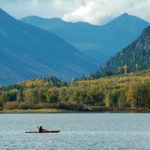Home »

Wetlands should be B.C.’s top conservation priority: NCC
Health status of wetland habitat across the province is not yet fully known
The conservation and restoration of wetlands in British Columbia must be a top priority, especially in the face of a changing climate, says Hillary Page, Director of Science and Stewardship with the Nature Conservancy of Canada, British Columbia Region.

Page makes this statement in recognition of World Wetlands Day on February 2.
“Wetlands are one of our most important conservation targets,” says Page. “We know that at least half of the wildlife in North America rely on wetlands for at least part of their lifecycle, and yet we don’t have a really complete picture of the extent and health of wetlands in this province.”
The Nature Conservancy of Canada (NCC) is looking at creating a comprehensive wetland inventory of its conservation lands in British Columbia. Mapping wetlands is a priority for the Wetlands Stewardship Partnership of BC, of which the Nature Conservancy of Canada is a member.
Restoration of wetlands is another critical component of wetlands conservation. Simple actions such as fencing to keep out grazing animals allow a degraded wetland to recover in just a few years, rebuilding natural habitat used by migratory birds, amphibians, small mammals and other wildlife.
“We have had significant success in restoring wetlands, even those that have been severely degraded by industrial activity,” says Page. “In just five years the Campbell River Estuary on Vancouver Island was transformed from an industrial wasteland to a thriving natural oasis. The fish and other sea life started to return within the first year of the restoration project.”
Other wetland projects in British Columbia by the Nature Conservancy of Canada include:
 – Fencing of interior, upland wetlands on properties in the Central Interior and Rocky Mountain Trench.
– Fencing of interior, upland wetlands on properties in the Central Interior and Rocky Mountain Trench.
– Restoration of historic oxbows on the Osoyoos floodplain in partnership with Ducks Unlimited Canada.
– Restoration of drained wetlands at the Cowichan Garry Oak Preserve in partnership with BC Wildlife Federation and Quamichan Lake Stewardship Society.
Facts
– Biologists estimate that more than 50% of wildlife species in North America rely on access to wetland habitat for at least part of their life cycle.
– Almost 35% of all rare, threatened and endangered species are dependent on wetlands.
– Wetlands store water for that can help mitigate droughts, and they absorb and store excess water in areas prone to flooding and erosion.
– Wetlands have the potential to mitigate the impacts of climate change by acting tempering temperature extremes in a local area.
– Wetlands serve as natural water treatment systems.
The Nature Conservancy of Canada is the nation’s leading land conservation organization, working to protect our most important natural areas and the species they sustain. Since 1962 NCC and its partners have helped to protect more than 2.7 million acres (over 1.1 million hectares), coast to coast. More than 1 million of the acres (400,000 hectares) are right here in British Columbia.
NCC







